Complex polytope
In geometry, a complex polytope is a generalization of a polytope in real space to an analogous structure in a complex Hilbert space, where each real dimension is accompanied by an imaginary one.
A complex polytope may be understood as a collection of complex points, lines, planes, and so on, where every point is the junction of multiple lines, every line of multiple planes, and so on.
Precise definitions exist only for the regular complex polytopes, which are configurations. The regular complex polytopes have been completely characterized, and can be described using a symbolic notation developed by Coxeter.
Some complex polytopes which are not fully regular have also been described.
Definitions and introduction
The complex line has one dimension with
A complex n-polytope in complex n-space is the analogue of a real n-polytope in real n-space.
There is no natural complex analogue of the ordering of points on a real line (or of the associated combinatorial properties). Because of this a complex polytope cannot be seen as a contiguous surface and it does not bound an interior in the way that a real polytope does.
In the case of regular polytopes, a precise definition can be made by using the notion of symmetry. For any
More fully, say that a collection P of affine subspaces (or flats) of a complex
- for every −1 ≤ i < j < k ≤ n, if F is a flat in P of dimension i and H is a flat in P of dimension k such that F ⊂ H then there are at least two flats G in P of dimension j such that F ⊂ G ⊂ H;
- for every i, j such that −1 ≤ i < j − 2, j ≤ n, if F ⊂ G are flats of P of dimensions i, j, then the set of flats between F and G is connected, in the sense that one can get from any member of this set to any other by a sequence of containments; and
- the subset of unitary transformations of V that fix P are transitive on the flags F0 ⊂ F1 ⊂ … ⊂Fn of flats of P (with Fi of dimension i for all i).
(Here, a flat of dimension −1 is taken to mean the empty set.) Thus, by definition, regular complex polytopes are configurations in complex unitary space.
The regular complex polytopes were discovered by Shephard (1952), and the theory was further developed by Coxeter (1974).
 This complex polygon has 8 edges (complex lines), labeled as a..h, and 16 vertices. Four vertices lie in each edge and two edges intersect at each vertex. In the left image, the outlined squares are not elements of the polytope but are included merely to help identify vertices lying in the same complex line. The octagonal perimeter of the left image is not an element of the polytope, but it is a petrie polygon.[3] In the middle image, each edge is represented as a real line and the four vertices in each line can be more clearly seen. |
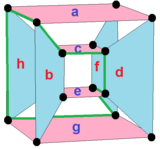 A perspective sketch representing the 16 vertex points as large black dots and the 8 4-edges as bounded squares within each edge. The green path represents the octagonal perimeter of the left hand image. |
A complex polytope exists in the complex space of equivalent dimension. For example, the vertices of a complex polygon are points in the complex plane , and the edges are complex lines existing as (affine) subspaces of the plane and intersecting at the vertices. Thus, an edge can be given a coordinate system consisting of a single complex number.[clarification needed]
In a regular complex polytope the vertices incident on the edge are arranged symmetrically about their
Three real projections of regular complex polygon 4{4}2 are illustrated above, with edges a, b, c, d, e, f, g, h. It has 16 vertices, which for clarity have not been individually marked. Each edge has four vertices and each vertex lies on two edges, hence each edge meets four other edges. In the first diagram, each edge is represented by a square. The sides of the square are not parts of the polygon but are drawn purely to help visually relate the four vertices. The edges are laid out symmetrically. (Note that the diagram looks similar to the B4 Coxeter plane projection of the tesseract, but it is structurally different).
The middle diagram abandons octagonal symmetry in favour of clarity. Each edge is shown as a real line, and each meeting point of two lines is a vertex. The connectivity between the various edges is clear to see.
The last diagram gives a flavour of the structure projected into three dimensions: the two cubes of vertices are in fact the same size but are seen in perspective at different distances away in the fourth dimension.
Regular complex one-dimensional polytopes
A real 1-dimensional polytope exists as a closed segment in the real line , defined by its two end points or vertices in the line. Its Schläfli symbol is {} .
Analogously, a complex 1-polytope exists as a set of p vertex points in the complex line . These may be represented as a set of points in an
Unlike points on the real line, points on the complex line have no natural ordering. Thus, unlike real polytopes, no interior can be defined.[5] Despite this, complex 1-polytopes are often drawn, as here, as a bounded regular polygon in the Argand plane.

A
The symmetry is denoted by the
A
In higher complex polytopes, 1-polytopes form p-edges. A 2-edge is similar to an ordinary real edge, in that it contains two vertices, but need not exist on a real line.
Regular complex polygons
While 1-polytopes can have unlimited p, finite regular complex polygons, excluding the double prism polygons p{4}2, are limited to 5-edge (pentagonal edges) elements, and infinite regular apeirogons also include 6-edge (hexagonal edges) elements.
Notations
Shephard's modified Schläfli notation
Shephard originally devised a modified form of Schläfli's notation for regular polytopes. For a polygon bounded by p1-edges, with a p2-set as vertex figure and overall symmetry group of order g, we denote the polygon as p1(g)p2.
The number of vertices V is then g/p2 and the number of edges E is g/p1.
The complex polygon illustrated above has eight square edges (p1=4) and sixteen vertices (p2=2). From this we can work out that g = 32, giving the modified Schläfli symbol 4(32)2.
Coxeter's revised modified Schläfli notation
A more modern notation p1{q}p2 is due to
The symmetry group p1[q]p2 is represented by 2 generators R1, R2, where: R1p1 = R2p2 = I. If q is even, (R2R1)q/2 = (R1R2)q/2. If q is odd, (R2R1)(q−1)/2R2 = (R1R2)(q−1)/2R1. When q is odd, p1=p2.
For 4[4]2 has R14 = R22 = I, (R2R1)2 = (R1R2)2.
For 3[5]3 has R13 = R23 = I, (R2R1)2R2 = (R1R2)2R1.
Coxeter-Dynkin diagrams
Coxeter also generalised the use of
One limitation, nodes connected by odd branch orders must have identical node orders. If they do not, the group will create "starry" polygons, with overlapping element. So ![]()
![]()
![]() and
and ![]()
![]()
![]() are ordinary, while
are ordinary, while ![]()
![]()
![]() is starry.
is starry.
12 Irreducible Shephard groups

p[2q]2 → p[q]p, index 2.
p[4]q → p[q]p, index q.

p[4]2 → [p], index p
p[4]2 → p[]×p[], index 2
Coxeter enumerated this list of regular complex polygons in . A regular complex polygon, p{q}r or ![]()
![]()
![]() , has p-edges, and r-gonal vertex figures. p{q}r is a finite polytope if (p+r)q>pr(q-2).
, has p-edges, and r-gonal vertex figures. p{q}r is a finite polytope if (p+r)q>pr(q-2).
Its symmetry is written as p[q]r, called a
For nonstarry groups, the order of the group p[q]r can be computed as .[9]
The
The rank 2 solutions that generate complex polygons are:
| Group | G3=G(q,1,1) | G2=G(p,1,2) | G4 | G6 | G5 | G8 | G14 | G9 | G10 | G20 | G16 | G21 | G17 | G18 |
|---|---|---|---|---|---|---|---|---|---|---|---|---|---|---|
| 2[q]2, q=3,4... | p[4]2, p=2,3... | 3[3]3 | 3[6]2 | 3[4]3 | 4[3]4 | 3[8]2 | 4[6]2 | 4[4]3 | 3[5]3 | 5[3]5 | 3[10]2 | 5[6]2 | 5[4]3 | |
| Order | 2q | 2p2 | 24 | 48 | 72 | 96 | 144 | 192 | 288 | 360 | 600 | 720 | 1200 | 1800 |
h
|
q | 2p | 6 | 12 | 24 | 30 | 60 | |||||||
Excluded solutions with odd q and unequal p and r are: 6[3]2, 6[3]3, 9[3]3, 12[3]3, ..., 5[5]2, 6[5]2, 8[5]2, 9[5]2, 4[7]2, 9[5]2, 3[9]2, and 3[11]2.
Other whole q with unequal p and r, create starry groups with overlapping fundamental domains: ![]()
![]()
![]() ,
, ![]()
![]()
![]() ,
, ![]()
![]()
![]() ,
, ![]()
![]()
![]() ,
, ![]()
![]()
![]() , and
, and ![]()
![]()
![]() .
.
The dual polygon of p{q}r is r{q}p. A polygon of the form p{q}p is self-dual. Groups of the form p[2q]2 have a half symmetry p[q]p, so a regular polygon ![]()
![]()
![]()
![]()
![]()
![]() is the same as quasiregular
is the same as quasiregular ![]()
![]()
![]()
![]()
![]() . As well, regular polygon with the same node orders,
. As well, regular polygon with the same node orders, ![]()
![]()
![]()
![]()
![]() , have an alternated construction
, have an alternated construction ![]()
![]()
![]()
![]()
![]()
![]() , allowing adjacent edges to be two different colors.[10]
, allowing adjacent edges to be two different colors.[10]
The group order, g, is used to compute the total number of vertices and edges. It will have g/r vertices, and g/p edges. When p=r, the number of vertices and edges are equal. This condition is required when q is odd.
Matrix generators
The group p[q]r, ![]()
![]()
![]() , can be represented by two matrices:[11]
, can be represented by two matrices:[11]
| Name | R1 |
R2 |
|---|---|---|
| Order | p | r |
| Matrix |
|
|
With
- k=
- Examples
|
|
| |||||||||||||||||||||||||||
|
|
|
Enumeration of regular complex polygons
Coxeter enumerated the complex polygons in Table III of Regular Complex Polytopes.[12]
| Group | Order | Coxeter number |
Polygon | Vertices | Edges | Notes | ||
|---|---|---|---|---|---|---|---|---|
| G(q,q,2) 2[q]2 = [q] q=2,3,4,... |
2q | q | 2{q}2 | q | q | {} | Real regular polygons Same as Same as | |
| Group | Order | Coxeter number |
Polygon | Vertices | Edges | Notes | |||
|---|---|---|---|---|---|---|---|---|---|
| G(p,1,2) p[4]2 p=2,3,4,... |
2p2 | 2p | p(2p2)2 | p{4}2 | |
p2 | 2p | p{} | same as p{}×p{} or representation as p-p duoprism |
| 2(2p2)p | 2{4}p | 2p | p2 | {} | representation as p-p duopyramid | ||||
| G(2,1,2) 2[4]2 = [4] |
8 | 4 | 2{4}2 = {4} | 4 | 4 | {} | same as {}×{} or Real square | ||
| G(3,1,2) 3[4]2 |
18 | 6 | 6(18)2 | 3{4}2 | 9 | 6 | 3{} | same as 3{}×3{} or representation as 3-3 duoprism | |
| 2(18)3 | 2{4}3 | 6 | 9 | {} | representation as 3-3 duopyramid
| ||||
| G(4,1,2) 4[4]2 |
32 | 8 | 8(32)2 | 4{4}2 | 16 | 8 | 4{} | same as 4{}×4{} or representation as 4-4 duoprism or {4,3,3} | |
| 2(32)4 | 2{4}4 | 8 | 16 | {} | representation as 4-4 duopyramid or {3,3,4} | ||||
| G(5,1,2) 5[4]2 |
50 | 25 | 5(50)2 | 5{4}2 | 25 | 10 | 5{} | same as 5{}×5{} or representation as 5-5 duoprism
| |
| 2(50)5 | 2{4}5 | 10 | 25 | {} | representation as 5-5 duopyramid
| ||||
| G(6,1,2) 6[4]2 |
72 | 36 | 6(72)2 | 6{4}2 | 36 | 12 | 6{} | same as 6{}×6{} or representation as 6-6 duoprism
| |
| 2(72)6 | 2{4}6 | 12 | 36 | {} | representation as 6-6 duopyramid
| ||||
| G4=G(1,1,2) 3[3]3 <2,3,3> |
24 | 6 | 3(24)3 | 3{3}3 | 8 | 8 | 3{} | Möbius–Kantor configuration self-dual, same as representation as {3,3,4} | |
| G6 3[6]2 |
48 | 12 | 3(48)2 | 3{6}2 | 24 | 16 | 3{} | same as | |
| 3{3}2 | starry polygon | ||||||||
| 2(48)3 | 2{6}3 | 16 | 24 | {} | |||||
| 2{3}3 | starry polygon | ||||||||
| G5 3[4]3 |
72 | 12 | 3(72)3 | 3{4}3 | 24 | 24 | 3{} | self-dual, same as representation as {3,4,3} | |
| G8 4[3]4 |
96 | 12 | 4(96)4 | 4{3}4 | 24 | 24 | 4{} | self-dual, same as representation as {3,4,3} | |
| G14 3[8]2 |
144 | 24 | 3(144)2 | 3{8}2 | 72 | 48 | 3{} | same as | |
| 3{8/3}2 | starry polygon, same as | ||||||||
| 2(144)3 | 2{8}3 | 48 | 72 | {} | |||||
| 2{8/3}3 | starry polygon | ||||||||
| G9 4[6]2 |
192 | 24 | 4(192)2 | 4{6}2 | 96 | 48 | 4{} | same as | |
| 2(192)4 | 2{6}4 | 48 | 96 | {} | |||||
| 4{3}2 | 96 | 48 | {} | starry polygon | |||||
| 2{3}4 | 48 | 96 | {} | starry polygon | |||||
| G10 4[4]3 |
288 | 24 | 4(288)3 | 4{4}3 | 96 | 72 | 4{} | ||
| 12 | 4{8/3}3 | starry polygon | |||||||
| 24 | 3(288)4 | 3{4}4 | 72 | 96 | 3{} | ||||
| 12 | 3{8/3}4 | starry polygon | |||||||
| G20 3[5]3 |
360 | 30 | 3(360)3 | 3{5}3 | 120 | 120 | 3{} | self-dual, same as representation as {3,3,5} | |
| 3{5/2}3 | self-dual, starry polygon | ||||||||
| G16 5[3]5 |
600 | 30 | 5(600)5 | 5{3}5 | 120 | 120 | 5{} | self-dual, same as representation as {3,3,5} | |
| 10 | 5{5/2}5 | self-dual, starry polygon | |||||||
| G21 3[10]2 |
720 | 60 | 3(720)2 | 3{10}2 | 360 | 240 | 3{} | same as | |
| 3{5}2 | starry polygon | ||||||||
| 3{10/3}2 | starry polygon, same as | ||||||||
| 3{5/2}2 | starry polygon | ||||||||
| 2(720)3 | 2{10}3 | 240 | 360 | {} | |||||
| 2{5}3 | starry polygon | ||||||||
| 2{10/3}3 | starry polygon | ||||||||
| 2{5/2}3 | starry polygon | ||||||||
| G17 5[6]2 |
1200 | 60 | 5(1200)2 | 5{6}2 | 600 | 240 | 5{} | same as | |
| 20 | 5{5}2 | starry polygon | |||||||
| 20 | 5{10/3}2 | starry polygon | |||||||
| 60 | 5{3}2 | starry polygon | |||||||
| 60 | 2(1200)5 | 2{6}5 | 240 | 600 | {} | ||||
| 20 | 2{5}5 | starry polygon | |||||||
| 20 | 2{10/3}5 | starry polygon | |||||||
| 60 | 2{3}5 | starry polygon | |||||||
| G18 5[4]3 |
1800 | 60 | 5(1800)3 | 5{4}3 | 600 | 360 | 5{} | ||
| 15 | 5{10/3}3 | starry polygon | |||||||
| 30 | 5{3}3 | starry polygon | |||||||
| 30 | 5{5/2}3 | starry polygon | |||||||
| 60 | 3(1800)5 | 3{4}5 | 360 | 600 | 3{} | ||||
| 15 | 3{10/3}5 | starry polygon | |||||||
| 30 | 3{3}5 | starry polygon | |||||||
| 30 | 3{5/2}5 | starry polygon | |||||||
Visualizations of regular complex polygons
Polygons of the form p{2r}q can be visualized by q color sets of p-edge. Each p-edge is seen as a regular polygon, while there are no faces.
- 2D orthogonal projections of complex polygons 2{r}q
Polygons of the form 2{4}q are called generalized
-
2{4}2,


 , with 4 vertices, and 4 edges
, with 4 vertices, and 4 edges -
2{4}3,


 , with 6 vertices, and 9 edges[13]
, with 6 vertices, and 9 edges[13] -
2{4}4,


 , with 8 vertices, and 16 edges
, with 8 vertices, and 16 edges -
2{4}5,


 , with 10 vertices, and 25 edges
, with 10 vertices, and 25 edges -
2{4}6,


 , with 12 vertices, and 36 edges
, with 12 vertices, and 36 edges -
2{4}7,


 , with 14 vertices, and 49 edges
, with 14 vertices, and 49 edges -
2{4}8,


 , with 16 vertices, and 64 edges
, with 16 vertices, and 64 edges -
2{4}9,


 , with 18 vertices, and 81 edges
, with 18 vertices, and 81 edges -
2{4}10,


 , with 20 vertices, and 100 edges
, with 20 vertices, and 100 edges
- Complex polygons p{4}2
Polygons of the form p{4}2 are called generalized hypercubes (squares for polygons). They share vertices with the 4D p-p duoprisms, vertices connected by p-edges. Vertices are drawn in green, and p-edges are drawn in alternate colors, red and blue. The perspective is distorted slightly for odd dimensions to move overlapping vertices from the center.
-
2{4}2,


 or
or 

 , with 4 vertices, and 4 2-edges
, with 4 vertices, and 4 2-edges -
4{4}2,


 or
or 

 , with 16 vertices, and 8 (square) 4-edges
, with 16 vertices, and 8 (square) 4-edges -
5{4}2,


 or
or 

 , with 25 vertices, and 10 (pentagonal) 5-edges
, with 25 vertices, and 10 (pentagonal) 5-edges -
6{4}2,


 or
or 

 , with 36 vertices, and 12 (hexagonal) 6-edges
, with 36 vertices, and 12 (hexagonal) 6-edges -
7{4}2,


 or
or 

 , with 49 vertices, and 14 (heptagonal)7-edges
, with 49 vertices, and 14 (heptagonal)7-edges -
8{4}2,


 or
or 

 , with 64 vertices, and 16 (octagonal) 8-edges
, with 64 vertices, and 16 (octagonal) 8-edges -
9{4}2,


 or
or 

 , with 81 vertices, and 18 (enneagonal) 9-edges
, with 81 vertices, and 18 (enneagonal) 9-edges -
10{4}2,


 or
or 

 , with 100 vertices, and 20 (decagonal) 10-edges
, with 100 vertices, and 20 (decagonal) 10-edges
- 3D perspective projections of complex polygons p{4}2. The duals 2{4}p
- are seen by adding vertices inside the edges, and adding edges in place of vertices.
-
3{4}2,


 or
or 

 with 9 vertices, 6 3-edges in 2 sets of colors
with 9 vertices, 6 3-edges in 2 sets of colors -
2{4}3,


 with 6 vertices, 9 edges in 3 sets
with 6 vertices, 9 edges in 3 sets -
4{4}2,


 or
or 

 with 16 vertices, 8 4-edges in 2 sets of colors and filled square 4-edges
with 16 vertices, 8 4-edges in 2 sets of colors and filled square 4-edges -
5{4}2,


 or
or 

 with 25 vertices, 10 5-edges in 2 sets of colors
with 25 vertices, 10 5-edges in 2 sets of colors
- Other Complex polygons p{r}2
-
3{6}2,


 or
or 

 , with 24 vertices in black, and 16 3-edges colored in 2 sets of 3-edges in red and blue[14]
, with 24 vertices in black, and 16 3-edges colored in 2 sets of 3-edges in red and blue[14] -
3{8}2,


 or
or 

 , with 72 vertices in black, and 48 3-edges colored in 2 sets of 3-edges in red and blue[15]
, with 72 vertices in black, and 48 3-edges colored in 2 sets of 3-edges in red and blue[15]
- 2D orthogonal projections of complex polygons, p{r}p
Polygons of the form p{r}p have equal number of vertices and edges. They are also self-dual.
Regular complex polytopes
In general, a regular complex polytope is represented by Coxeter as p{z1}q{z2}r{z3}s… or Coxeter diagram ![]()
![]()
![]()
![]()
![]()
![]()
![]()
![]()
![]()
![]()
![]()
![]()
![]()
![]()
![]()
![]() …, having symmetry p[z1]q[z2]r[z3]s… or
…, having symmetry p[z1]q[z2]r[z3]s… or ![]()
![]()
![]()
![]()
![]()
![]()
![]()
![]()
![]()
![]()
![]()
![]()
![]()
![]()
![]()
![]() ….[20]
….[20]
There are infinite families of regular complex polytopes that occur in all dimensions, generalizing the
n = p{4}2{3}2…2{3}2 and diagram
n = 2{3}2{3}2…2{4}p and diagram
A 1-dimensional regular complex polytope in is represented as ![]() , having p vertices, with its real representation a regular polygon, {p}. Coxeter also gives it symbol γp
, having p vertices, with its real representation a regular polygon, {p}. Coxeter also gives it symbol γp
1 or βp
1 as 1-dimensional generalized hypercube or cross polytope. Its symmetry is p[] or ![]() , a cyclic group of order p. In a higher polytope, p{} or
, a cyclic group of order p. In a higher polytope, p{} or ![]() represents a p-edge element, with a 2-edge, {} or
represents a p-edge element, with a 2-edge, {} or ![]() , representing an ordinary real edge between two vertices.[21]
, representing an ordinary real edge between two vertices.[21]
A dual complex polytope is constructed by exchanging k and (n-1-k)-elements of an n-polytope. For example, a dual complex polygon has vertices centered on each edge, and new edges are centered at the old vertices. A v-valence vertex creates a new v-edge, and e-edges become e-valence vertices.[22] The dual of a regular complex polytope has a reversed symbol. Regular complex polytopes with symmetric symbols, i.e. p{q}p, p{q}r{q}p, p{q}r{s}r{q}p, etc. are self dual.
Enumeration of regular complex polyhedra

Coxeter enumerated this list of nonstarry regular complex polyhedra in , including the 5 platonic solids in .[23]
A regular complex polyhedron, p{n1}q{n2}r or ![]()
![]()
![]()
![]()
![]()
![]()
![]()
![]()
![]()
![]()
![]() , has
, has ![]()
![]()
![]()
![]()
![]()
![]() faces,
faces, ![]() edges, and
edges, and ![]()
![]()
![]()
![]()
![]()
![]() vertex figures.
vertex figures.
A complex regular polyhedron p{n1}q{n2}r requires both g1 = order(p[n1]q) and g2 = order(q[n2]r) be finite.
Given g = order(p[n1]q[n2]r), the number of vertices is g/g2, and the number of faces is g/g1. The number of edges is g/pr.
| Space | Group | Order | Coxeter number |
Polygon | Vertices | Edges | Faces | Vertex figure |
Van Oss polygon |
Notes | |||
|---|---|---|---|---|---|---|---|---|---|---|---|---|---|
| G(1,1,3) 2[3]2[3]2 = [3,3] |
24 | 4 | α3 = 2{3}2{3}2 = {3,3} |
4 | 6 | {} | 4 | {3} | {3} | none | Real tetrahedron Same as | ||
| G23 2[3]2[5]2 = [3,5] |
120 | 10 | 2{3}2{5}2 = {3,5} | 12 | 30 | {} | 20 | {3} | {5} | none | Real icosahedron | ||
| 2{5}2{3}2 = {5,3} | 20 | 30 | {} | 12 | {5} | {3} | none | Real dodecahedron | |||||
| G(2,1,3) 2[3]2[4]2 = [3,4] |
48 | 6 | β2 3 = β3 = {3,4} |
6 | 12 | {} | 8 | {3} | {4} | {4} | Real octahedron Same as {}+{}+{}, order 8 Same as | ||
| γ2 3 = γ3 = {4,3} |
8 | 12 | {} | 6 | {4} | {3} | none | Real cube Same as {}×{}×{} or | |||||
| G(p,1,3) 2[3]2[4]p p=2,3,4,... |
6p3 | 3p | βp 3 = 2{3}2{4}p |
|
3p | 3p2 | {} | p3 | {3} | 2{4}p | 2{4}p | Generalized octahedron Same as p{}+p{}+p{}, order p3 Same as | |
| γp 3 = p{4}2{3}2 |
p3 | 3p2 | p{} | 3p | p{4}2 | {3} | none | Generalized cube Same as p{}×p{}×p{} or | |||||
| G(3,1,3) 2[3]2[4]3 |
162 | 9 | β3 3 = 2{3}2{4}3 |
9 | 27 | {} | 27 | {3} | 2{4}3 | 2{4}3 | Same as 3{}+3{}+3{}, order 27 Same as | ||
| γ3 3 = 3{4}2{3}2 |
27 | 27 | 3{} | 9 | 3{4}2 | {3} | none | Same as 3{}×3{}×3{} or | |||||
| G(4,1,3) 2[3]2[4]4 |
384 | 12 | β4 3 = 2{3}2{4}4 |
12 | 48 | {} | 64 | {3} | 2{4}4 | 2{4}4 | Same as 4{}+4{}+4{}, order 64 Same as | ||
| γ4 3 = 4{4}2{3}2 |
64 | 48 | 4{} | 12 | 4{4}2 | {3} | none | Same as 4{}×4{}×4{} or | |||||
| G(5,1,3) 2[3]2[4]5 |
750 | 15 | β5 3 = 2{3}2{4}5 |
15 | 75 | {} | 125 | {3} | 2{4}5 | 2{4}5 | Same as 5{}+5{}+5{}, order 125 Same as | ||
| γ5 3 = 5{4}2{3}2 |
125 | 75 | 5{} | 15 | 5{4}2 | {3} | none | Same as 5{}×5{}×5{} or | |||||
| G(6,1,3) 2[3]2[4]6 |
1296 | 18 | β6 3 = 2{3}2{4}6 |
36 | 108 | {} | 216 | {3} | 2{4}6 | 2{4}6 | Same as 6{}+6{}+6{}, order 216 Same as | ||
| γ6 3 = 6{4}2{3}2 |
216 | 108 | 6{} | 18 | 6{4}2 | {3} | none | Same as 6{}×6{}×6{} or | |||||
| G25 3[3]3[3]3 |
648 | 9 | 3{3}3{3}3 | 27 | 72 | 3{} | 27 | 3{3}3 | 3{3}3 | 3{4}2 | Same as representation as 221 Hessian polyhedron | ||
| G26 2[4]3[3]3 |
1296 | 18 | 2{4}3{3}3 | 54 | 216 | {} | 72 | 2{4}3 | 3{3}3 | {6} | |||
| 3{3}3{4}2 | 72 | 216 | 3{} | 54 | 3{3}3 | 3{4}2 | 3{4}3 | Same as representation as 122 | |||||
Visualizations of regular complex polyhedra
- 2D orthogonal projections of complex polyhedra, p{s}t{r}r
-
2{4}3{3}3,




 has 54 vertices, 216 simple edges, and 72 faces, with one face highlighted blue.[26]
has 54 vertices, 216 simple edges, and 72 faces, with one face highlighted blue.[26] -
- Generalized octahedra
Generalized octahedra have a regular construction as ![]()
![]()
![]()
![]()
![]() and quasiregular form as
and quasiregular form as ![]()
![]()
![]()
![]() . All elements are simplexes.
. All elements are simplexes.
-
2{3}2{4}3,




 or
or 

 , with 9 vertices, 27 edges, and 27 faces
, with 9 vertices, 27 edges, and 27 faces -
2{3}2{4}4,




 or
or 


 , with 12 vertices, 48 edges, and 64 faces
, with 12 vertices, 48 edges, and 64 faces -
2{3}2{4}5,




 or
or 


 , with 15 vertices, 75 edges, and 125 faces
, with 15 vertices, 75 edges, and 125 faces -
2{3}2{4}6,




 or
or 


 , with 18 vertices, 108 edges, and 216 faces
, with 18 vertices, 108 edges, and 216 faces -
2{3}2{4}7,




 or
or 


 , with 21 vertices, 147 edges, and 343 faces
, with 21 vertices, 147 edges, and 343 faces -
2{3}2{4}8,




 or
or 


 , with 24 vertices, 192 edges, and 512 faces
, with 24 vertices, 192 edges, and 512 faces -
2{3}2{4}9,




 or
or 


 , with 27 vertices, 243 edges, and 729 faces
, with 27 vertices, 243 edges, and 729 faces -
2{3}2{4}10,




 or
or 



 , with 30 vertices, 300 edges, and 1000 faces
, with 30 vertices, 300 edges, and 1000 faces
- Generalized cubes
Generalized cubes have a regular construction as ![]()
![]()
![]()
![]()
![]() and prismatic construction as
and prismatic construction as ![]()
![]()
![]()
![]()
![]() , a product of three p-gonal 1-polytopes. Elements are lower dimensional generalized cubes.
, a product of three p-gonal 1-polytopes. Elements are lower dimensional generalized cubes.
-
4{4}2{3}2,




 or
or 



 , with 64 vertices, 48 edges, and 12 faces
, with 64 vertices, 48 edges, and 12 faces -
5{4}2{3}2,




 or
or 



 , with 125 vertices, 75 edges, and 15 faces
, with 125 vertices, 75 edges, and 15 faces -
6{4}2{3}2,




 or
or 



 , with 216 vertices, 108 edges, and 18 faces
, with 216 vertices, 108 edges, and 18 faces -
7{4}2{3}2,




 or
or 



 , with 343 vertices, 147 edges, and 21 faces
, with 343 vertices, 147 edges, and 21 faces -
8{4}2{3}2,




 or
or 



 , with 512 vertices, 192 edges, and 24 faces
, with 512 vertices, 192 edges, and 24 faces -
9{4}2{3}2,




 or
or 



 , with 729 vertices, 243 edges, and 27 faces
, with 729 vertices, 243 edges, and 27 faces -
10{4}2{3}2,




 or
or 



 , with 1000 vertices, 300 edges, and 30 faces
, with 1000 vertices, 300 edges, and 30 faces
Enumeration of regular complex 4-polytopes
Coxeter enumerated this list of nonstarry regular complex 4-polytopes in , including the 6
| Space | Group | Order | Coxeter number |
Polytope | Vertices | Edges | Faces | Cells | Van Oss polygon |
Notes |
|---|---|---|---|---|---|---|---|---|---|---|
| G(1,1,4) 2[3]2[3]2[3]2 = [3,3,3] |
120 | 5 | α4 = 2{3}2{3}2{3}2 = {3,3,3} |
5 | 10 {} |
10 {3} |
5 {3,3} |
none | Real 5-cell (simplex) | |
| G28 2[3]2[4]2[3]2 = [3,4,3] |
1152 | 12 | 2{3}2{4}2{3}2 = {3,4,3} |
24 | 96 {} |
96 {3} |
24 {3,4} |
{6} | Real 24-cell | |
| G30 2[3]2[3]2[5]2 = [3,3,5] |
14400 | 30 | 2{3}2{3}2{5}2 = {3,3,5} |
120 | 720 {} |
1200 {3} |
600 {3,3} |
{10} | Real 600-cell | |
| 2{5}2{3}2{3}2 = {5,3,3} |
600 | 1200 {} |
720 {5} |
120 {5,3} |
Real 120-cell | |||||
| G(2,1,4) 2[3]2[3]2[4]p =[3,3,4] |
384 | 8 | β2 4 = β4 = {3,3,4} |
8 | 24 {} |
32 {3} |
16 {3,3} |
{4} | Real 16-cell Same as | |
| γ2 4 = γ4 = {4,3,3} |
16 | 32 {} |
24 {4} |
8 {4,3} |
none | Real tesseract Same as {}4 or | ||||
| G(p,1,4) 2[3]2[3]2[4]p p=2,3,4,... |
24p4 | 4p | βp 4 = 2{3}2{3}2{4}p |
4p | 6p2 {} |
4p3 {3} |
p4 {3,3} |
2{4}p | Generalized 4- orthoplex Same as | |
| γp 4 = p{4}2{3}2{3}2 |
p4 | 4p3 p{} |
6p2 p{4}2 |
4p p{4}2{3}2 |
none | Generalized tesseract Same as p{}4 or | ||||
| G(3,1,4) 2[3]2[3]2[4]3 |
1944 | 12 | β3 4 = 2{3}2{3}2{4}3 |
12 | 54 {} |
108 {3} |
81 {3,3} |
2{4}3 | Generalized 4- orthoplex Same as | |
| γ3 4 = 3{4}2{3}2{3}2 |
81 | 108 3{} |
54 3{4}2 |
12 3{4}2{3}2 |
none | Same as 3{}4 or | ||||
| G(4,1,4) 2[3]2[3]2[4]4 |
6144 | 16 | β4 4 = 2{3}2{3}2{4}4 |
16 | 96 {} |
256 {3} |
64 {3,3} |
2{4}4 | Same as | |
| γ4 4 = 4{4}2{3}2{3}2 |
256 | 256 4{} |
96 4{4}2 |
16 4{4}2{3}2 |
none | Same as 4{}4 or | ||||
| G(5,1,4) 2[3]2[3]2[4]5 |
15000 | 20 | β5 4 = 2{3}2{3}2{4}5 |
20 | 150 {} |
500 {3} |
625 {3,3} |
2{4}5 | Same as | |
| γ5 4 = 5{4}2{3}2{3}2 |
625 | 500 5{} |
150 5{4}2 |
20 5{4}2{3}2 |
none | Same as 5{}4 or | ||||
| G(6,1,4) 2[3]2[3]2[4]6 |
31104 | 24 | β6 4 = 2{3}2{3}2{4}6 |
24 | 216 {} |
864 {3} |
1296 {3,3} |
2{4}6 | Same as | |
| γ6 4 = 6{4}2{3}2{3}2 |
1296 | 864 6{} |
216 6{4}2 |
24 6{4}2{3}2 |
none | Same as 6{}4 or | ||||
| G32 3[3]3[3]3[3]3 |
155520 | 30 | 3{3}3{3}3{3}3 |
240 | 2160 3{} |
2160 3{3}3 |
240 3{3}3{3}3 |
3{4}3 | Witting polytope representation as 421 |
Visualizations of regular complex 4-polytopes
-
Real {3,3,3},






 , had 5 vertices, 10 edges, 10 {3} faces, and 5 {3,3} cells
, had 5 vertices, 10 edges, 10 {3} faces, and 5 {3,3} cells -
Real {3,4,3},






 , had 24 vertices, 96 edges, 96 {3} faces, and 24 {3,4} cells
, had 24 vertices, 96 edges, 96 {3} faces, and 24 {3,4} cells -
Real {5,3,3},






 , had 600 vertices, 1200 edges, 720 {5} faces, and 120 {5,3} cells
, had 600 vertices, 1200 edges, 720 {5} faces, and 120 {5,3} cells -
Real {3,3,5},






 , had 120 vertices, 720 edges, 1200 {3} faces, and 600 {3,3} cells
, had 120 vertices, 720 edges, 1200 {3} faces, and 600 {3,3} cells -
Witting polytope,






 , has 240 vertices, 2160 3-edges, 2160 3{3}3 faces, and 240 3{3}3{3}3 cells
, has 240 vertices, 2160 3-edges, 2160 3{3}3 faces, and 240 3{3}3{3}3 cells
- Generalized 4-orthoplexes
Generalized 4-orthoplexes have a regular construction as ![]()
![]()
![]()
![]()
![]()
![]()
![]() and quasiregular form as
and quasiregular form as ![]()
![]()
![]()
![]()
![]()
![]() . All elements are simplexes.
. All elements are simplexes.
-
2{3}2{3}2{4}3,






 or
or 



 , with 12 vertices, 54 edges, 108 faces, and 81 cells
, with 12 vertices, 54 edges, 108 faces, and 81 cells -
2{3}2{3}2{4}4,






 or
or 




 , with 16 vertices, 96 edges, 256 faces, and 256 cells
, with 16 vertices, 96 edges, 256 faces, and 256 cells -
2{3}2{3}2{4}5,






 or
or 




 , with 20 vertices, 150 edges, 500 faces, and 625 cells
, with 20 vertices, 150 edges, 500 faces, and 625 cells -
2{3}2{3}2{4}6,






 or
or 




 , with 24 vertices, 216 edges, 864 faces, and 1296 cells
, with 24 vertices, 216 edges, 864 faces, and 1296 cells -
2{3}2{3}2{4}7,






 or
or 




 , with 28 vertices, 294 edges, 1372 faces, and 2401 cells
, with 28 vertices, 294 edges, 1372 faces, and 2401 cells -
2{3}2{3}2{4}8,






 or
or 




 , with 32 vertices, 384 edges, 2048 faces, and 4096 cells
, with 32 vertices, 384 edges, 2048 faces, and 4096 cells -
2{3}2{3}2{4}9,






 or
or 




 , with 36 vertices, 486 edges, 2916 faces, and 6561 cells
, with 36 vertices, 486 edges, 2916 faces, and 6561 cells -
2{3}2{3}2{4}10,






 or
or 





 , with 40 vertices, 600 edges, 4000 faces, and 10000 cells
, with 40 vertices, 600 edges, 4000 faces, and 10000 cells
- Generalized 4-cubes
Generalized tesseracts have a regular construction as ![]()
![]()
![]()
![]()
![]()
![]()
![]() and prismatic construction as
and prismatic construction as ![]()
![]()
![]()
![]()
![]()
![]()
![]() , a product of four p-gonal 1-polytopes. Elements are lower dimensional generalized cubes.
, a product of four p-gonal 1-polytopes. Elements are lower dimensional generalized cubes.
-
3{4}2{3}2{3}2,






 or
or 





 , with 81 vertices, 108 edges, 54 faces, and 12 cells
, with 81 vertices, 108 edges, 54 faces, and 12 cells -
4{4}2{3}2{3}2,






 or
or 





 , with 256 vertices, 96 edges, 96 faces, and 16 cells
, with 256 vertices, 96 edges, 96 faces, and 16 cells -
5{4}2{3}2{3}2,






 or
or 





 , with 625 vertices, 500 edges, 150 faces, and 20 cells
, with 625 vertices, 500 edges, 150 faces, and 20 cells -
6{4}2{3}2{3}2,






 or
or 





 , with 1296 vertices, 864 edges, 216 faces, and 24 cells
, with 1296 vertices, 864 edges, 216 faces, and 24 cells -
7{4}2{3}2{3}2,






 or
or 





 , with 2401 vertices, 1372 edges, 294 faces, and 28 cells
, with 2401 vertices, 1372 edges, 294 faces, and 28 cells -
8{4}2{3}2{3}2,






 or
or 





 , with 4096 vertices, 2048 edges, 384 faces, and 32 cells
, with 4096 vertices, 2048 edges, 384 faces, and 32 cells -
9{4}2{3}2{3}2,






 or
or 





 , with 6561 vertices, 2916 edges, 486 faces, and 36 cells
, with 6561 vertices, 2916 edges, 486 faces, and 36 cells -
10{4}2{3}2{3}2,






 or
or 





 , with 10000 vertices, 4000 edges, 600 faces, and 40 cells
, with 10000 vertices, 4000 edges, 600 faces, and 40 cells
Enumeration of regular complex 5-polytopes
Regular complex 5-polytopes in or higher exist in three families, the real
| Space | Group | Order | Polytope | Vertices | Edges | Faces | Cells | 4-faces | Van Oss polygon |
Notes |
|---|---|---|---|---|---|---|---|---|---|---|
| G(1,1,5) = [3,3,3,3] |
720 | α5 = {3,3,3,3} |
6 | 15 {} |
20 {3} |
15 {3,3} |
6 {3,3,3} |
none | Real 5-simplex | |
| G(2,1,5) =[3,3,3,4] |
3840 | β2 5 = β5 = {3,3,3,4} |
10 | 40 {} |
80 {3} |
80 {3,3} |
32 {3,3,3} |
{4} | Real 5-orthoplex Same as | |
| γ2 5 = γ5 = {4,3,3,3} |
32 | 80 {} |
80 {4} |
40 {4,3} |
10 {4,3,3} |
none | Real 5-cube Same as {}5 or | |||
| G(p,1,5) 2[3]2[3]2[3]2[4]p |
120p5 | βp 5 = 2{3}2{3}2{3}2{4}p |
5p | 10p2 {} |
10p3 {3} |
5p4 {3,3} |
p5 {3,3,3} |
2{4}p | Generalized 5-orthoplex Same as | |
| γp 5 = p{4}2{3}2{3}2{3}2 |
p5 | 5p4 p{} |
10p3 p{4}2 |
10p2 p{4}2{3}2 |
5p p{4}2{3}2{3}2 |
none | Generalized 5-cube Same as p{}5 or | |||
| G(3,1,5) 2[3]2[3]2[3]2[4]3 |
29160 | β3 5 = 2{3}2{3}2{3}2{4}3 |
15 | 90 {} |
270 {3} |
405 {3,3} |
243 {3,3,3} |
2{4}3 | Same as | |
| γ3 5 = 3{4}2{3}2{3}2{3}2 |
243 | 405 3{} |
270 3{4}2 |
90 3{4}2{3}2 |
15 3{4}2{3}2{3}2 |
none | Same as 3{}5 or | |||
| G(4,1,5) 2[3]2[3]2[3]2[4]4 |
122880 | β4 5 = 2{3}2{3}2{3}2{4}4 |
20 | 160 {} |
640 {3} |
1280 {3,3} |
1024 {3,3,3} |
2{4}4 | Same as | |
| γ4 5 = 4{4}2{3}2{3}2{3}2 |
1024 | 1280 4{} |
640 4{4}2 |
160 4{4}2{3}2 |
20 4{4}2{3}2{3}2 |
none | Same as 4{}5 or | |||
| G(5,1,5) 2[3]2[3]2[3]2[4]5 |
375000 | β5 5 = 2{3}2{3}2{3}2{5}5 |
25 | 250 {} |
1250 {3} |
3125 {3,3} |
3125 {3,3,3} |
2{5}5 | Same as | |
| γ5 5 = 5{4}2{3}2{3}2{3}2 |
3125 | 3125 5{} |
1250 5{5}2 |
250 5{5}2{3}2 |
25 5{4}2{3}2{3}2 |
none | Same as 5{}5 or | |||
| G(6,1,5) 2[3]2[3]2[3]2[4]6 |
933210 | β6 5 = 2{3}2{3}2{3}2{4}6 |
30 | 360 {} |
2160 {3} |
6480 {3,3} |
7776 {3,3,3} |
2{4}6 | Same as | |
| γ6 5 = 6{4}2{3}2{3}2{3}2 |
7776 | 6480 6{} |
2160 6{4}2 |
360 6{4}2{3}2 |
30 6{4}2{3}2{3}2 |
none | Same as 6{}5 or |
Visualizations of regular complex 5-polytopes
- Generalized 5-orthoplexes
Generalized 5-orthoplexes have a regular construction as ![]()
![]()
![]()
![]()
![]()
![]()
![]()
![]()
![]() and quasiregular form as
and quasiregular form as ![]()
![]()
![]()
![]()
![]()
![]()
![]()
![]() . All elements are simplexes.
. All elements are simplexes.
-
Real {3,3,3,4},








 , with 10 vertices, 40 edges, 80 faces, 80 cells, and 32 4-faces
, with 10 vertices, 40 edges, 80 faces, 80 cells, and 32 4-faces -
2{3}2{3}2{3}2{4}3,








 , with 15 vertices, 90 edges, 270 faces, 405 cells, and 243 4-faces
, with 15 vertices, 90 edges, 270 faces, 405 cells, and 243 4-faces -
2{3}2{3}2{3}2{4}4,








 , with 20 vertices, 160 edges, 640 faces, 1280 cells, and 1024 4-faces
, with 20 vertices, 160 edges, 640 faces, 1280 cells, and 1024 4-faces -
2{3}2{3}2{3}2{4}5,








 , with 25 vertices, 250 edges, 1250 faces, 3125 cells, and 3125 4-faces
, with 25 vertices, 250 edges, 1250 faces, 3125 cells, and 3125 4-faces -
2{3}2{3}2{3}2{4}6,








 , with 30 vertices, 360 edges, 2160 faces, 6480 cells, 7776 4-faces
, with 30 vertices, 360 edges, 2160 faces, 6480 cells, 7776 4-faces -
2{3}2{3}2{3}2{4}7,








 , with 35 vertices, 490 edges, 3430 faces, 12005 cells, 16807 4-faces
, with 35 vertices, 490 edges, 3430 faces, 12005 cells, 16807 4-faces -
2{3}2{3}2{3}2{4}8,








 , with 40 vertices, 640 edges, 5120 faces, 20480 cells, 32768 4-faces
, with 40 vertices, 640 edges, 5120 faces, 20480 cells, 32768 4-faces -
2{3}2{3}2{3}2{4}9,








 , with 45 vertices, 810 edges, 7290 faces, 32805 cells, 59049 4-faces
, with 45 vertices, 810 edges, 7290 faces, 32805 cells, 59049 4-faces -
2{3}2{3}2{3}2{4}10,








 , with 50 vertices, 1000 edges, 10000 faces, 50000 cells, 100000 4-faces
, with 50 vertices, 1000 edges, 10000 faces, 50000 cells, 100000 4-faces
- Generalized 5-cubes
Generalized 5-cubes have a regular construction as ![]()
![]()
![]()
![]()
![]()
![]()
![]()
![]()
![]() and prismatic construction as
and prismatic construction as ![]()
![]()
![]()
![]()
![]()
![]()
![]()
![]()
![]() , a product of five p-gonal 1-polytopes. Elements are lower dimensional generalized cubes.
, a product of five p-gonal 1-polytopes. Elements are lower dimensional generalized cubes.
-
Real {4,3,3,3},








 , with 32 vertices, 80 edges, 80 faces, 40 cells, and 10 4-faces
, with 32 vertices, 80 edges, 80 faces, 40 cells, and 10 4-faces -
3{4}2{3}2{3}2{3}2,








 , with 243 vertices, 405 edges, 270 faces, 90 cells, and 15 4-faces
, with 243 vertices, 405 edges, 270 faces, 90 cells, and 15 4-faces -
4{4}2{3}2{3}2{3}2,








 , with 1024 vertices, 1280 edges, 640 faces, 160 cells, and 20 4-faces
, with 1024 vertices, 1280 edges, 640 faces, 160 cells, and 20 4-faces -
5{4}2{3}2{3}2{3}2,








 , with 3125 vertices, 3125 edges, 1250 faces, 250 cells, and 25 4-faces
, with 3125 vertices, 3125 edges, 1250 faces, 250 cells, and 25 4-faces -
6{4}2{3}2{3}2{3}2,








 , with 7776 vertices, 6480 edges, 2160 faces, 360 cells, and 30 4-faces
, with 7776 vertices, 6480 edges, 2160 faces, 360 cells, and 30 4-faces
Enumeration of regular complex 6-polytopes
| Space | Group | Order | Polytope | Vertices | Edges | Faces | Cells | 4-faces | 5-faces | Van Oss polygon |
Notes |
|---|---|---|---|---|---|---|---|---|---|---|---|
| G(1,1,6) = [3,3,3,3,3] |
720 | α6 = {3,3,3,3,3} |
7 | 21 {} |
35 {3} |
35 {3,3} |
21 {3,3,3} |
7 {3,3,3,3} |
none | Real 6-simplex | |
| G(2,1,6) [3,3,3,4] |
46080 | β2 6 = β6 = {3,3,3,4} |
12 | 60 {} |
160 {3} |
240 {3,3} |
192 {3,3,3} |
64 {3,3,3,3} |
{4} | Real 6-orthoplex Same as | |
| γ2 6 = γ6 = {4,3,3,3} |
64 | 192 {} |
240 {4} |
160 {4,3} |
60 {4,3,3} |
12 {4,3,3,3} |
none | Real 6-cube Same as {}6 or | |||
| G(p,1,6) 2[3]2[3]2[3]2[4]p |
720p6 | βp 6 = 2{3}2{3}2{3}2{4}p |
6p | 15p2 {} |
20p3 {3} |
15p4 {3,3} |
6p5 {3,3,3} |
p6 {3,3,3,3} |
2{4}p | Generalized 6-orthoplex Same as | |
| γp 6 = p{4}2{3}2{3}2{3}2 |
p6 | 6p5 p{} |
15p4 p{4}2 |
20p3 p{4}2{3}2 |
15p2 p{4}2{3}2{3}2 |
6p p{4}2{3}2{3}2{3}2 |
none | Generalized 6-cube Same as p{}6 or |
Visualizations of regular complex 6-polytopes
- Generalized 6-orthoplexes
Generalized 6-orthoplexes have a regular construction as ![]()
![]()
![]()
![]()
![]()
![]()
![]()
![]()
![]()
![]()
![]() and quasiregular form as
and quasiregular form as ![]()
![]()
![]()
![]()
![]()
![]()
![]()
![]()
![]()
![]() . All elements are simplexes.
. All elements are simplexes.
-
Real {3,3,3,3,4},










 , with 12 vertices, 60 edges, 160 faces, 240 cells, 192 4-faces, and 64 5-faces
, with 12 vertices, 60 edges, 160 faces, 240 cells, 192 4-faces, and 64 5-faces -
2{3}2{3}2{3}2{3}2{4}3,










 , with 18 vertices, 135 edges, 540 faces, 1215 cells, 1458 4-faces, and 729 5-faces
, with 18 vertices, 135 edges, 540 faces, 1215 cells, 1458 4-faces, and 729 5-faces -
2{3}2{3}2{3}2{3}2{4}4,










 , with 24 vertices, 240 edges, 1280 faces, 3840 cells, 6144 4-faces, and 4096 5-faces
, with 24 vertices, 240 edges, 1280 faces, 3840 cells, 6144 4-faces, and 4096 5-faces -
2{3}2{3}2{3}2{3}2{4}5,










 , with 30 vertices, 375 edges, 2500 faces, 9375 cells, 18750 4-faces, and 15625 5-faces
, with 30 vertices, 375 edges, 2500 faces, 9375 cells, 18750 4-faces, and 15625 5-faces -
2{3}2{3}2{3}2{3}2{4}6,










 , with 36 vertices, 540 edges, 4320 faces, 19440 cells, 46656 4-faces, and 46656 5-faces
, with 36 vertices, 540 edges, 4320 faces, 19440 cells, 46656 4-faces, and 46656 5-faces -
2{3}2{3}2{3}2{3}2{4}7,










 , with 42 vertices, 735 edges, 6860 faces, 36015 cells, 100842 4-faces, 117649 5-faces
, with 42 vertices, 735 edges, 6860 faces, 36015 cells, 100842 4-faces, 117649 5-faces -
2{3}2{3}2{3}2{3}2{4}8,










 , with 48 vertices, 960 edges, 10240 faces, 61440 cells, 196608 4-faces, 262144 5-faces
, with 48 vertices, 960 edges, 10240 faces, 61440 cells, 196608 4-faces, 262144 5-faces -
2{3}2{3}2{3}2{3}2{4}9,










 , with 54 vertices, 1215 edges, 14580 faces, 98415 cells, 354294 4-faces, 531441 5-faces
, with 54 vertices, 1215 edges, 14580 faces, 98415 cells, 354294 4-faces, 531441 5-faces -
2{3}2{3}2{3}2{3}2{4}10,










 , with 60 vertices, 1500 edges, 20000 faces, 150000 cells, 600000 4-faces, 1000000 5-faces
, with 60 vertices, 1500 edges, 20000 faces, 150000 cells, 600000 4-faces, 1000000 5-faces
- Generalized 6-cubes
Generalized 6-cubes have a regular construction as ![]()
![]()
![]()
![]()
![]()
![]()
![]()
![]()
![]()
![]()
![]() and prismatic construction as
and prismatic construction as ![]()
![]()
![]()
![]()
![]()
![]()
![]()
![]()
![]()
![]()
![]() , a product of six p-gonal 1-polytopes. Elements are lower dimensional generalized cubes.
, a product of six p-gonal 1-polytopes. Elements are lower dimensional generalized cubes.
-
Real {3,3,3,3,3,4},










 , with 64 vertices, 192 edges, 240 faces, 160 cells, 60 4-faces, and 12 5-faces
, with 64 vertices, 192 edges, 240 faces, 160 cells, 60 4-faces, and 12 5-faces -
3{4}2{3}2{3}2{3}2{3}2,










 , with 729 vertices, 1458 edges, 1215 faces, 540 cells, 135 4-faces, and 18 5-faces
, with 729 vertices, 1458 edges, 1215 faces, 540 cells, 135 4-faces, and 18 5-faces -
4{4}2{3}2{3}2{3}2{3}2,










 , with 4096 vertices, 6144 edges, 3840 faces, 1280 cells, 240 4-faces, and 24 5-faces
, with 4096 vertices, 6144 edges, 3840 faces, 1280 cells, 240 4-faces, and 24 5-faces -
5{4}2{3}2{3}2{3}2{3}2,










 , with 15625 vertices, 18750 edges, 9375 faces, 2500 cells, 375 4-faces, and 30 5-faces
, with 15625 vertices, 18750 edges, 9375 faces, 2500 cells, 375 4-faces, and 30 5-faces
Enumeration of regular complex apeirotopes
Coxeter enumerated this list of nonstarry regular complex apeirotopes or honeycombs.[28]
For each dimension there are 12 apeirotopes symbolized as δp,r
n+1 exists in any dimensions , or if p=q=2. Coxeter calls these generalized cubic honeycombs for n>2.[29]
Each has proportional element counts given as:
- k-faces = , where and n! denotes the factorial of n.
Regular complex 1-polytopes
The only regular complex 1-polytope is ∞{}, or ![]() . Its real representation is an apeirogon, {∞}, or
. Its real representation is an apeirogon, {∞}, or ![]()
![]()
![]() .
.
Regular complex apeirogons





 is a mixture of two regular apeirogons
is a mixture of two regular apeirogons 

 and
and 

 , seen here with blue and pink edges.
, seen here with blue and pink edges. 

 has only one color of edges because q is odd, making it a double covering.
has only one color of edges because q is odd, making it a double covering.Rank 2 complex apeirogons have symmetry p[q]r, where 1/p + 2/q + 1/r = 1. Coxeter expresses them as δp,r
2 where q is constrained to satisfy q = 2/(1 – (p + r)/pr).[30]
There are 8 solutions:
| 2[∞]2 | 3[12]2 | 4[8]2 | 6[6]2 | 3[6]3 | 6[4]3 | 4[4]4 | 6[3]6 |
There are two excluded solutions odd q and unequal p and r: 10[5]2 and 12[3]4, or ![]()
![]()
![]() and
and ![]()
![]()
![]() .
.
A regular complex apeirogon p{q}r has p-edges and r-gonal vertex figures. The dual apeirogon of p{q}r is r{q}p. An apeirogon of the form p{q}p is self-dual. Groups of the form p[2q]2 have a half symmetry p[q]p, so a regular apeirogon ![]()
![]()
![]()
![]() is the same as quasiregular
is the same as quasiregular ![]()
![]()
![]() .[31]
.[31]
Apeirogons can be represented on the
Including affine nodes, and , there are 3 more infinite solutions: ∞[2]∞, ∞[4]2, ∞[3]3, and ![]()
![]()
![]() ,
, ![]()
![]()
![]() , and
, and ![]()
![]()
![]() . The first is an index 2 subgroup of the second. The vertices of these apeirogons exist in .
. The first is an index 2 subgroup of the second. The vertices of these apeirogons exist in .
| Space | Group | Apeirogon | Edge | rep.[32] | Picture | Notes | |
|---|---|---|---|---|---|---|---|
| 2[∞]2 = [∞] | δ2,2 2 = {∞} |
|
{} | Real apeirogon Same as | |||
| / | ∞[4]2 | ∞{4}2 | ∞{} | {4,4} |  |
Same as 
| |
| ∞[3]3 | ∞{3}3 | ∞{} | {3,6} | Same as | |||
| p[q]r | δp,r 2 = p{q}r |
p{} | |||||
| 3[12]2 | δ3,2 2 = 3{12}2 |
3{} | r{3,6} |  |
Same as 
| ||
| δ2,3 2 = 2{12}3 |
{} | {6,3} |  |
||||
| 3[6]3 | δ3,3 2 = 3{6}3 |
3{} | {3,6} | Same as | |||
| 4[8]2 | δ4,2 2 = 4{8}2 |
4{} | {4,4} |  |
Same as 
| ||
| δ2,4 2 = 2{8}4 |
{} | {4,4} |  |
||||
| 4[4]4 | δ4,4 2 = 4{4}4 |
4{} | {4,4} |  |
Same as | ||
| 6[6]2 | δ6,2 2 = 6{6}2 |
6{} | r{3,6} | Same as | |||
| δ2,6 2 = 2{6}6 |
{} | {3,6} | |||||
| 6[4]3 | δ6,3 2 = 6{4}3 |
6{} | {6,3} |  |
|||
| δ3,6 2 = 3{4}6 |
3{} | {3,6} | |||||
| 6[3]6 | δ6,6 2 = 6{3}6 |
6{} | {3,6} |  |
Same as | ||
Regular complex apeirohedra
There are 22 regular complex apeirohedra, of the form p{a}q{b}r. 8 are self-dual (p=r and a=b), while 14 exist as dual polytope pairs. Three are entirely real (p=q=r=2).
Coxeter symbolizes 12 of them as δp,r
3 or p{4}2{4}r is the regular form of the product apeirotope δp,r
2 × δp,r
2 or p{q}r × p{q}r, where q is determined from p and r.
![]()
![]()
![]()
![]()
![]() is the same as
is the same as ![]()
![]()
![]()
![]() , as well as
, as well as ![]()
![]()
![]()
![]()
![]()
![]()
![]() , for p,r=2,3,4,6. Also
, for p,r=2,3,4,6. Also ![]()
![]()
![]()
![]()
![]() =
= ![]()
![]()
![]()
![]()
![]() .[33]
.[33]
| Space | Group | Apeirohedron | Vertex | Edge | Face | van Oss apeirogon |
Notes | |||
|---|---|---|---|---|---|---|---|---|---|---|
| 2[3]2[4]∞ | ∞{4}2{3}2 | ∞{} | ∞{4}2 | Same as ∞{}×∞{}×∞{} or Real representation {4,3,4} | ||||||
| p[4]2[4]r | p{4}2{4}r | |
p2 | 2pr | p{} | r2 | p{4}2 | 2{q}r | Same as | |
| [4,4] | δ2,2 3 = {4,4} |
4 | 8 | {} | 4 | {4} | {∞} | Real square tiling Same as | ||
| 3[4]2[4]2 3[4]2[4]3 4[4]2[4]2 4[4]2[4]4 6[4]2[4]2 6[4]2[4]3 6[4]2[4]6 |
3{4}2{4}2 2{4}2{4}3 3{4}2{4}3 4{4}2{4}2 2{4}2{4}4 4{4}2{4}4 6{4}2{4}2 2{4}2{4}6 6{4}2{4}3 3{4}2{4}6 6{4}2{4}6 |
9 4 9 16 4 16 36 4 36 9 36 |
12 12 18 16 16 32 24 24 36 36 72 |
3{} {} 3{} 4{} {} 4{} 6{} {} 6{} 3{} 6{} |
4 9 9 4 16 16 4 36 9 36 36 |
3{4}2 {4} 3{4}2 4{4}2 {4} 4{4}2 6{4}2 {4} 6{4}2 3{4}2 6{4}2 |
p{q}r | Same as Same as Same as Same as Same as Same as Same as Same as Same as Same as Same as | ||
| Space | Group | Apeirohedron | Vertex | Edge | Face | van Oss apeirogon |
Notes | |||
|---|---|---|---|---|---|---|---|---|---|---|
| 2[4]r[4]2 | 2{4}r{4}2 | |
2 | {} | 2 | p{4}2' | 2{4}r | Same as | ||
| [4,4] | {4,4} | 2 | 4 | {} | 2 | {4} | {∞} | Same as | ||
| 2[4]3[4]2 2[4]4[4]2 2[4]6[4]2 |
2{4}3{4}2 2{4}4{4}2 2{4}6{4}2 |
2 | 9 16 36 |
{} | 2 | 2{4}3 2{4}4 2{4}6 |
2{q}r | Same as Same as Same as | ||
| Space | Group | Apeirohedron | Vertex | Edge | Face | van Oss apeirogon |
Notes | |||
|---|---|---|---|---|---|---|---|---|---|---|
| 2[6]2[3]2 = [6,3] |
{3,6} | |
1 | 3 | {} | 2 | {3} | {∞} | Real triangular tiling | |
| {6,3} | 2 | 3 | {} | 1 | {6} | none | Real hexagonal tiling | |||
| 3[4]3[3]3 | 3{3}3{4}3 | 1 | 8 | 3{} | 3 | 3{3}3 | 3{4}6 | Same as | ||
| 3{4}3{3}3 | 3 | 8 | 3{} | 1 | 3{4}3 | 3{12}2 | ||||
| 4[3]4[3]4 | 4{3}4{3}4 | 1 | 6 | 4{} | 1 | 4{3}4 | 4{4}4 | Self-dual, same as | ||
| 4[3]4[4]2 | 4{3}4{4}2 | 1 | 12 | 4{} | 3 | 4{3}4 | 2{8}4 | Same as | ||
| 2{4}4{3}4 | 3 | 12 | {} | 1 | 2{4}4 | 4{4}4 | ||||
Regular complex 3-apeirotopes
There are 16 regular complex apeirotopes in . Coxeter expresses 12 of them by δp,r
3 where q is constrained to satisfy q = 2/(1 – (p + r)/pr). These can also be decomposed as product apeirotopes: ![]()
![]()
![]()
![]()
![]()
![]()
![]() =
= ![]()
![]()
![]()
![]()
![]()
![]()
![]()
![]()
![]()
![]()
![]() . The first case is the cubic honeycomb.
. The first case is the cubic honeycomb.
| Space | Group | 3-apeirotope | Vertex | Edge | Face | Cell | van Oss apeirogon |
Notes |
|---|---|---|---|---|---|---|---|---|
| p[4]2[3]2[4]r | δp,r 3 = p{4}2{3}2{4}r |
p{} | p{4}2 | p{4}2{3}2 | p{q}r | Same as | ||
| 2[4]2[3]2[4]2 =[4,3,4] |
δ2,2 3 = 2{4}2{3}2{4}2 |
{} | {4} | {4,3} | Cubic honeycomb Same as | |||
| 3[4]2[3]2[4]2 | δ3,2 3 = 3{4}2{3}2{4}2 |
3{} | 3{4}2 | 3{4}2{3}2 | Same as | |||
| δ2,3 3 = 2{4}2{3}2{4}3 |
{} | {4} | {4,3} | Same as | ||||
| 3[4]2[3]2[4]3 | δ3,3 3 = 3{4}2{3}2{4}3 |
3{} | 3{4}2 | 3{4}2{3}2 | Same as | |||
| 4[4]2[3]2[4]2 | δ4,2 3 = 4{4}2{3}2{4}2 |
4{} | 4{4}2 | 4{4}2{3}2 | Same as | |||
| δ2,4 3 = 2{4}2{3}2{4}4 |
{} | {4} | {4,3} | Same as | ||||
| 4[4]2[3]2[4]4 | δ4,4 3 = 4{4}2{3}2{4}4 |
4{} | 4{4}2 | 4{4}2{3}2 | Same as | |||
| 6[4]2[3]2[4]2 | δ6,2 3 = 6{4}2{3}2{4}2 |
6{} | 6{4}2 | 6{4}2{3}2 | Same as | |||
| δ2,6 3 = 2{4}2{3}2{4}6 |
{} | {4} | {4,3} | Same as | ||||
| 6[4]2[3]2[4]3 | δ6,3 3 = 6{4}2{3}2{4}3 |
6{} | 6{4}2 | 6{4}2{3}2 | Same as | |||
| δ3,6 3 = 3{4}2{3}2{4}6 |
3{} | 3{4}2 | 3{4}2{3}2 | Same as | ||||
| 6[4]2[3]2[4]6 | δ6,6 3 = 6{4}2{3}2{4}6 |
6{} | 6{4}2 | 6{4}2{3}2 | Same as |
| Space | Group | 3-apeirotope | Vertex | Edge | Face | Cell | van Oss apeirogon |
Notes |
|---|---|---|---|---|---|---|---|---|
| 2[4]3[3]3[3]3 | 3{3}3{3}3{4}2 |
1 | 24 3{} | 27 3{3}3 | 2 3{3}3{3}3 | 3{4}6 | Same as | |
| 2{4}3{3}3{3}3 |
2 | 27 {} | 24 2{4}3 | 1 2{4}3{3}3 | 2{12}3 | |||
| 2[3]2[4]3[3]3 | 2{3}2{4}3{3}3 |
1 | 27 {} | 72 2{3}2 | 8 2{3}2{4}3 | 2{6}6 | ||
| 3{3}3{4}2{3}2 |
8 | 72 3{} | 27 3{3}3 | 1 3{3}3{4}2 | 3{6}3 | Same as |
Regular complex 4-apeirotopes
There are 15 regular complex apeirotopes in . Coxeter expresses 12 of them by δp,r
4 where q is constrained to satisfy q = 2/(1 – (p + r)/pr). These can also be decomposed as product apeirotopes: ![]()
![]()
![]()
![]()
![]()
![]()
![]()
![]()
![]() =
= ![]()
![]()
![]()
![]()
![]()
![]()
![]()
![]()
![]()
![]()
![]()
![]()
![]()
![]()
![]() . The first case is the tesseractic honeycomb. The 16-cell honeycomb and 24-cell honeycomb are real solutions. The last solution is generated has Witting polytope elements.
. The first case is the tesseractic honeycomb. The 16-cell honeycomb and 24-cell honeycomb are real solutions. The last solution is generated has Witting polytope elements.
| Space | Group | 4-apeirotope | Vertex | Edge | Face | Cell | 4-face | van Oss apeirogon |
Notes |
|---|---|---|---|---|---|---|---|---|---|
| p[4]2[3]2[3]2[4]r | δp,r 4 = p{4}2{3}2{3}2{4}r |
p{} | p{4}2 | p{4}2{3}2 | p{4}2{3}2{3}2 | p{q}r | Same as | ||
| 2[4]2[3]2[3]2[4]2 | δ2,2 4 = {4,3,3,3} |
{} | {4} | {4,3} | {4,3,3} | {∞} | Tesseractic honeycomb Same as | ||
| 2[3]2[4]2[3]2[3]2 =[3,4,3,3] |
{3,3,4,3} |
1 | 12 {} | 32 {3} | 24 {3,3} | 3 {3,3,4} | Real 16-cell honeycomb Same as | ||
| {3,4,3,3} |
3 | 24 {} | 32 {3} | 12 {3,4} | 1 {3,4,3} | Real 24-cell honeycomb Same as | |||
| 3[3]3[3]3[3]3[3]3 | 3{3}3{3}3{3}3{3}3 |
1 | 80 3{} | 270 3{3}3 | 80 3{3}3{3}3 | 1 3{3}3{3}3{3}3 | 3{4}6 | representation 521 |
Regular complex 5-apeirotopes and higher
There are only 12 regular complex apeirotopes in or higher,[35] expressed δp,r
n where q is constrained to satisfy q = 2/(1 – (p + r)/pr). These can also be decomposed a product of n apeirogons: ![]()
![]()
![]()
![]()
![]() ...
... ![]()
![]()
![]()
![]()
![]()
![]() =
= ![]()
![]()
![]()
![]()
![]()
![]()
![]() ...
... ![]()
![]()
![]()
![]()
![]()
![]()
![]() . The first case is the real
. The first case is the real
| Space | Group | 5-apeirotopes | Vertices | Edge | Face | Cell | 4-face | 5-face | van Oss apeirogon |
Notes |
|---|---|---|---|---|---|---|---|---|---|---|
| p[4]2[3]2[3]2[3]2[4]r | δp,r 5 = p{4}2{3}2{3}2{3}2{4}r |
p{} | p{4}2 | p{4}2{3}2 | p{4}2{3}2{3}2 | p{4}2{3}2{3}2{3}2 | p{q}r | Same as | ||
| 2[4]2[3]2[3]2[3]2[4]2 =[4,3,3,3,4] |
δ2,2 5 = {4,3,3,3,4} |
{} | {4} | {4,3} | {4,3,3} | {4,3,3,3} | {∞} | 5-cubic honeycomb Same as |
van Oss polygon

A van Oss polygon is a regular polygon in the plane (real plane , or unitary plane ) in which both an edge and the centroid of a regular polytope lie, and formed of elements of the polytope. Not all regular polytopes have Van Oss polygons.
For example, the van Oss polygons of a real octahedron are the three squares whose planes pass through its center. In contrast a cube does not have a van Oss polygon because the edge-to-center plane cuts diagonally across two square faces and the two edges of the cube which lie in the plane do not form a polygon.
Infinite honeycombs also have van Oss apeirogons. For example, the real square tiling and triangular tiling have apeirogons {∞} van Oss apeirogons.[36]
If it exists, the van Oss polygon of regular complex polytope of the form p{q}r{s}t... has p-edges.
Non-regular complex polytopes
Product complex polytopes
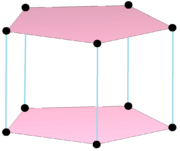 Complex product polygon |
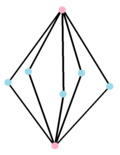 The dual polygon,{}+5{} has 7 vertices centered on the edges of the original, connected by 10 edges. Its real representation is a pentagonal bipyramid. |
Some complex polytopes can be represented as Cartesian products. These product polytopes are not strictly regular since they'll have more than one facet type, but some can represent lower symmetry of regular forms if all the orthogonal polytopes are identical. For example, the product p{}×p{} or ![]()
![]()
![]() of two 1-dimensional polytopes is the same as the regular p{4}2 or
of two 1-dimensional polytopes is the same as the regular p{4}2 or ![]()
![]()
![]() . More general products, like p{}×q{} have real representations as the 4-dimensional p-q duoprisms. The dual of a product polytope can be written as a sum p{}+q{} and have real representations as the 4-dimensional p-q duopyramid. The p{}+p{} can have its symmetry doubled as a regular complex polytope 2{4}p or
. More general products, like p{}×q{} have real representations as the 4-dimensional p-q duoprisms. The dual of a product polytope can be written as a sum p{}+q{} and have real representations as the 4-dimensional p-q duopyramid. The p{}+p{} can have its symmetry doubled as a regular complex polytope 2{4}p or ![]()
![]()
![]() .
.
Similarly, a complex polyhedron can be constructed as a triple product: p{}×p{}×p{} or ![]()
![]()
![]()
![]()
![]() is the same as the regular generalized cube, p{4}2{3}2 or
is the same as the regular generalized cube, p{4}2{3}2 or ![]()
![]()
![]()
![]()
![]() , as well as product p{4}2×p{} or
, as well as product p{4}2×p{} or ![]()
![]()
![]()
![]()
![]() .[37]
.[37]
Quasiregular polygons
A quasiregular polygon is a truncation of a regular polygon. A quasiregular polygon ![]()
![]()
![]() contains alternate edges of the regular polygons
contains alternate edges of the regular polygons ![]()
![]()
![]() and
and ![]()
![]()
![]() . The quasiregular polygon has p vertices on the p-edges of the regular form.
. The quasiregular polygon has p vertices on the p-edges of the regular form.
Quasiregular apeirogons
There are 7 quasiregular complex apeirogons which alternate edges of a regular apeirogon and its regular dual. The vertex arrangements of these apeirogon have real representations with the regular and uniform tilings of the Euclidean plane. The last column for the 6{3}6 apeirogon is not only self-dual, but the dual coincides with itself with overlapping hexagonal edges, thus their quasiregular form also has overlapping hexagonal edges, so it can't be drawn with two alternating colors like the others. The symmetry of the self-dual families can be doubled, so creating an identical geometry as the regular forms: ![]()
![]()
![]() =
= ![]()
![]()
![]()
![]()
| p[q]r | 4[8]2 | 4[4]4 | 6[6]2 | 6[4]3 | 3[12]2 | 3[6]3 | 6[3]6 |
|---|---|---|---|---|---|---|---|
| Regular |
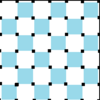 |
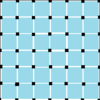 |
 |
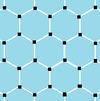 |
 |
 |
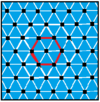 |
| Quasiregular |
 |
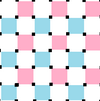 |
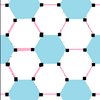 |
 |
 |
 |
 |
| Regular dual |
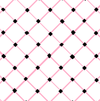 |
 |
 |
 |
 |
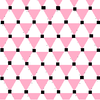 |
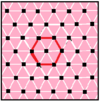 |
Quasiregular polyhedra





 , to its rectified limit, showing outlined-green triangles faces at the start, and blue 2{4}3,
, to its rectified limit, showing outlined-green triangles faces at the start, and blue 2{4}3, 

 , vertex figures expanding as new faces.
, vertex figures expanding as new faces.Like real polytopes, a complex quasiregular polyhedron can be constructed as a rectification (a complete truncation) of a regular polyhedron. Vertices are created mid-edge of the regular polyhedron and faces of the regular polyhedron and its dual are positioned alternating across common edges.
For example, a p-generalized cube, ![]()
![]()
![]()
![]()
![]() , has p3 vertices, 3p2 edges, and 3p p-generalized square faces, while the p-generalized octahedron,
, has p3 vertices, 3p2 edges, and 3p p-generalized square faces, while the p-generalized octahedron, ![]()
![]()
![]()
![]()
![]() , has 3p vertices, 3p2 edges and p3 triangular faces. The middle quasiregular form p-generalized cuboctahedron,
, has 3p vertices, 3p2 edges and p3 triangular faces. The middle quasiregular form p-generalized cuboctahedron, ![]()
![]()
![]()
![]()
![]() , has 3p2 vertices, 3p3 edges, and 3p+p3 faces.
, has 3p2 vertices, 3p3 edges, and 3p+p3 faces.
Also the rectification of the Hessian polyhedron ![]()
![]()
![]()
![]()
![]() , is
, is ![]()
![]()
![]()
![]()
![]() , a quasiregular form sharing the geometry of the regular complex polyhedron
, a quasiregular form sharing the geometry of the regular complex polyhedron ![]()
![]()
![]()
![]()
![]() .
.
| Generalized cube/octahedra | Hessian polyhedron | |||||
|---|---|---|---|---|---|---|
| p=2 (real) | p=3 | p=4 | p=5 | p=6 | ||
| Generalized cubes (regular) |
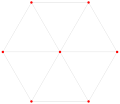 Cube |
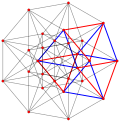 |
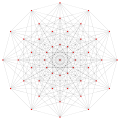 |
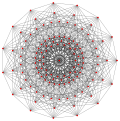 |
 |
 |
| Generalized cuboctahedra (quasiregular) |
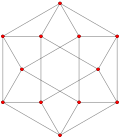 Cuboctahedron |
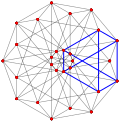 |
 |
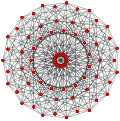 |
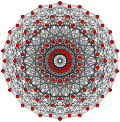 |
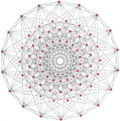 |
| Generalized octahedra (regular) |
 Octahedron |
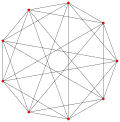 |
 |
 |
 |
 |
Other complex polytopes with unitary reflections of period two
Other nonregular complex polytopes can be constructed within unitary reflection groups that don't make linear Coxeter graphs. In Coxeter diagrams with loops Coxeter marks a special period interior, like ![]()
![]()
![]() or symbol (11 1 1)3, and group [1 1 1]3.[38][39] These complex polytopes have not been systematically explored beyond a few cases.
or symbol (11 1 1)3, and group [1 1 1]3.[38][39] These complex polytopes have not been systematically explored beyond a few cases.
The group ![]()
![]()
![]() is defined by 3 unitary reflections, R1, R2, R3, all order 2: R12 = R12 = R32 = (R1R2)3 = (R2R3)3 = (R3R1)3 = (R1R2R3R1)p = 1. The period p can be seen as a
is defined by 3 unitary reflections, R1, R2, R3, all order 2: R12 = R12 = R32 = (R1R2)3 = (R2R3)3 = (R3R1)3 = (R1R2R3R1)p = 1. The period p can be seen as a
As with all Wythoff constructions, polytopes generated by reflections, the number of vertices of a single-ringed Coxeter diagram polytope is equal to the order of the group divided by the order of the subgroup where the ringed node is removed. For example, a real cube has Coxeter diagram ![]()
![]()
![]()
![]()
![]() , with octahedral symmetry
, with octahedral symmetry ![]()
![]()
![]()
![]()
![]() order 48, and subgroup dihedral symmetry
order 48, and subgroup dihedral symmetry ![]()
![]()
![]() order 6, so the number of vertices of a cube is 48/6=8. Facets are constructed by removing one node furthest from the ringed node, for example
order 6, so the number of vertices of a cube is 48/6=8. Facets are constructed by removing one node furthest from the ringed node, for example ![]()
![]()
![]() for the cube. Vertex figures are generated by removing a ringed node and ringing one or more connected nodes, and
for the cube. Vertex figures are generated by removing a ringed node and ringing one or more connected nodes, and ![]()
![]()
![]() for the cube.
for the cube.
Coxeter represents these groups by the following symbols. Some groups have the same order, but a different structure, defining the same vertex arrangement in complex polytopes, but different edges and higher elements, like ![]()
![]()
![]() and
and ![]()
![]()
![]()
![]() with p≠3.[40]
with p≠3.[40]
| Coxeter diagram | Order | Symbol or Position in Table VII of Shephard and Todd (1954) |
|---|---|---|
| pn − 1 n!, p ≥ 3 | G(p, p, n), [p], [1 1 1]p, [1 1 (n−2)p]3 | |
| 72·6!, 108·9! | Nos. 33, 34, [1 2 2]3, [1 2 3]3 | |
| 14·4!, 3·6!, 64·5! | Nos. 24, 27, 29 |
Coxeter calls some of these complex polyhedra almost regular because they have regular facets and vertex figures. The first is a lower symmetry form of the generalized cross-polytope in . The second is a fractional generalized cube, reducing p-edges into single vertices leaving ordinary 2-edges. Three of them are related to the
| Space | Group | Order | Coxeter symbols |
Vertices | Edges | Faces | Vertex figure |
Notes |
|---|---|---|---|---|---|---|---|---|
| [1 1 1p]3 p=2,3,4... |
6p2 | (1 1 11p)3 |
3p | 3p2 | {3} | {2p} | Shephard symbol (1 1; 11)p same as βp 3 = | |
| (11 1 1p)3 |
p2 | {3} | {6} | Shephard symbol (11 1; 1)p 1/p γp 3 | ||||
| [1 1 12]3 |
24 | (1 1 112)3 |
6 | 12 | 8 {3} | {4} | Same as β2 3 = | |
| (11 1 12)3 |
4 | 6 | 4 {3} | {3} | 1/2 γ2 3 = | |||
| [1 1 1]3 |
54 | (1 1 11)3 |
9 | 27 | {3} | {6} | Shephard symbol (1 1; 11)3 same as β3 3 = | |
| (11 1 1)3 |
9 | 27 | {3} | {6} | Shephard symbol (11 1; 1)3 1/3 γ3 3 = β3 3 | |||
| [1 1 14]3 |
96 | (1 1 114)3 |
12 | 48 | {3} | {8} | Shephard symbol (1 1; 11)4 same as β4 3 = | |
| (11 1 14)3 |
16 | {3} | {6} | Shephard symbol (11 1; 1)4 1/4 γ4 3 | ||||
| [1 1 15]3 |
150 | (1 1 115)3 |
15 | 75 | {3} | {10} | Shephard symbol (1 1; 11)5 same as β5 3 = | |
| (11 1 15)3 |
25 | {3} | {6} | Shephard symbol (11 1; 1)5 1/5 γ5 3 | ||||
| [1 1 16]3 |
216 | (1 1 116)3 |
18 | 216 | {3} | {12} | Shephard symbol (1 1; 11)6 same as β6 3 = | |
| (11 1 16)3 |
36 | {3} | {6} | Shephard symbol (11 1; 1)6 1/6 γ6 3 | ||||
| [1 1 14]4 |
336 | (1 1 114)4 |
42 | 168 | 112 {3} | {8} | representation {3,8|,4} = {3,8}8 | |
| (11 1 14)4 |
56 | {3} | {6} | |||||
| [1 1 15]4 |
2160 | (1 1 115)4 |
216 | 1080 | 720 {3} | {10} | representation {3,10|,4} = {3,10}8 | |
| (11 1 15)4 |
360 | {3} | {6} | |||||
| [1 1 14]5 |
(1 1 114)5 |
270 | 1080 | 720 {3} | {8} | representation {3,8|,5} = {3,8}10 | ||
| (11 1 14)5 |
360 | {3} | {6} |
Coxeter defines other groups with anti-unitary constructions, for example these three. The first was discovered and drawn by Peter McMullen in 1966.[42]
| Space | Group | Order | Coxeter symbols |
Vertices | Edges | Faces | Vertex figure |
Notes |
|---|---|---|---|---|---|---|---|---|
| [1 14 14](3) |
336 | (11 14 14)(3) |
56 | 168 | 84 {4} | {6} | representation {4,6|,3} = {4,6}6 | |
| [15 14 14](3) |
2160 | (115 14 14)(3) |
216 | 1080 | 540 {4} | {10} | representation {4,10|,3} = {4,10}6 | |
| [14 15 15](3) |
(114 15 15)(3) |
270 | 1080 | 432 {5} | {8} | representation {5,8|,3} = {5,8}6 |
| Space | Group | Order | Coxeter symbols |
Vertices | Other elements |
Cells | Vertex figure |
Notes |
|---|---|---|---|---|---|---|---|---|
| [1 1 2p]3 p=2,3,4... |
24p3 | (1 1 22p)3 |
4p | Shephard (22 1; 1)p same as βp 4 = | ||||
| (11 1 2p )3 |
p3 | Shephard (2 1; 11)p 1/p γp 4 | ||||||
| [1 1 22]3 =[31,1,1] |
192 | (1 1 222)3 |
8 | 24 edges 32 faces |
16 |
β2 4 = | ||
| (11 1 22 )3 |
1/2 γ2 4 = 4, real 16-cell | |||||||
| [1 1 2]3 |
648 | (1 1 22)3 |
12 | Shephard (22 1; 1)3 same as β3 4 = | ||||
| (11 1 23)3 |
27 | Shephard (2 1; 11)3 1/3 γ3 4 | ||||||
| [1 1 24]3 |
1536 | (1 1 224)3 |
16 | Shephard (22 1; 1)4 same as β4 4 = | ||||
| (11 1 24 )3 |
64 | Shephard (2 1; 11)4 1/4 γ4 4 | ||||||
| [14 1 2]3 |
7680 | (22 14 1)3 |
80 | Shephard (22 1; 1)4 | ||||
| (114 1 2)3 |
160 | Shephard (2 1; 11)4 | ||||||
| (11 14 2)3 |
320 | Shephard (2 11; 1)4 | ||||||
| [1 1 2]4 |
(1 1 22)4 |
80 | 640 edges 1280 triangles |
640 |
||||
| (11 1 2)4 |
320 |
| Space | Group | Order | Coxeter symbols |
Vertices | Edges | Facets | Vertex figure |
Notes |
|---|---|---|---|---|---|---|---|---|
| [1 1 3p]3 p=2,3,4... |
120p4 | (1 1 33p)3 |
5p | Shephard (33 1; 1)p same as βp 5 = | ||||
| (11 1 3p)3 |
p4 | Shephard (3 1; 11)p 1/p γp 5 | ||||||
| [2 2 1]3 |
51840 | (2 1 22)3 |
80 | Shephard (2 1; 22)3 | ||||
| (2 11 2)3 |
432 | Shephard (2 11; 2)3 |
| Space | Group | Order | Coxeter symbols |
Vertices | Edges | Facets | Vertex figure |
Notes |
|---|---|---|---|---|---|---|---|---|
| [1 1 4p]3 p=2,3,4... |
720p5 | (1 1 44p)3 |
6p | Shephard (44 1; 1)p same as βp 6 = | ||||
| (11 1 4p)3 |
p5 | Shephard (4 1; 11)p 1/p γp 6 | ||||||
| [1 2 3]3 |
39191040 | (2 1 33)3 |
756 | Shephard (2 1; 33)3 | ||||
| (22 1 3)3 |
4032 | Shephard (22 1; 3)3 | ||||||
| (2 11 3)3 |
54432 | Shephard (2 11; 3)3 |
Visualizations
-
(1 1 114)4,



 has 42 vertices, 168 edges and 112 triangular faces, seen in this 14-gonal projection.
has 42 vertices, 168 edges and 112 triangular faces, seen in this 14-gonal projection. -
(14 14 11)(3),


 has 56 vertices, 168 edges and 84 square faces, seen in this 14-gonal projection.
has 56 vertices, 168 edges and 84 square faces, seen in this 14-gonal projection. -
(1 1 22)4,




 has 80 vertices, 640 edges, 1280 triangular faces and 640 tetrahedral cells, seen in this 20-gonal projection.[43]
has 80 vertices, 640 edges, 1280 triangular faces and 640 tetrahedral cells, seen in this 20-gonal projection.[43]
See also
Notes
- ^ Peter Orlik, Victor Reiner, Anne V. Shepler. The sign representation for Shephard groups. Mathematische Annalen. March 2002, Volume 322, Issue 3, pp 477–492. DOI:10.1007/s002080200001 [1]
- ^ Coxeter, Regular Complex Polytopes, p. 115
- ^ Coxeter, Regular Complex Polytopes, 11.3 Petrie Polygon, a simple h-gon formed by the orbit of the flag (O0,O0O1) for the product of the two generating reflections of any nonstarry regular complex polygon, p1{q}p2.
- ^ Complex Regular Polytopes,11.1 Regular complex polygons p.103
- ^ Shephard, 1952; "It is from considerations such as these that we derive the notion of the interior of a polytope, and it will be seen that in unitary space where the numbers cannot be so ordered such a concept of interior is impossible. [Para break] Hence ... we have to consider unitary polytopes as configurations."
- ^ Coxeter, Regular Complex polytopes, p. 96
- ^ Coxeter, Regular Complex Polytopes, p. xiv
- ^ Coxeter, Complex Regular Polytopes, p. 177, Table III
- ^ Lehrer & Taylor 2009, p. 87
- ^ Coxeter, Regular Complex Polytopes, Table IV. The regular polygons. pp. 178–179
- ^ Complex Polytopes, 8.9 The Two-Dimensional Case, p. 88
- ^ Regular Complex Polytopes, Coxeter, pp. 177-179
- ^ a b Coxeter, Regular Complex Polytopes, p. 108
- ^ Coxeter, Regular Complex Polytopes, p. 109
- ^ Coxeter, Regular Complex Polytopes, p. 111
- ^ Coxeter, Regular Complex Polytopes, p. 30 diagram and p. 47 indices for 8 3-edges
- ^ a b Coxeter, Regular Complex Polytopes, p. 110
- ^ Coxeter, Regular Complex Polytopes, p. 48
- ^ Coxeter, Regular Complex Polytopes, p. 49
- ^ Coxeter, Regular Complex Polytopes, pp. 116–140.
- ^ a b Coxeter, Regular Complex Polytopes, pp. 118–119.
- ^ Complex Regular Polytopes, p.29
- ^ a b Coxeter, Regular Complex Polytopes, Table V. The nonstarry regular polyhedra and 4-polytopes. p. 180.
- ^ Coxeter, Kaleidoscopes — Selected Writings of H.S.M. Coxeter, Paper 25 Surprising relationships among unitary reflection groups, p. 431.
- ^ a b Coxeter, Regular Complex Polytopes, p. 131
- ^ Coxeter, Regular Complex Polytopes, p. 126
- ^ Coxeter, Regular Complex Polytopes, p. 125
- ^ Coxeter, Regular Complex Polytopes, Table VI. The regular honeycombs. p. 180.
- ^ Complex regular polytope, p.174
- ^ Coxeter, Regular Complex Polytopes, Table VI. The regular honeycombs. p. 111, 136.
- ^ Coxeter, Regular Complex Polytopes, Table IV. The regular polygons. pp. 178–179
- ^ Coxeter, Regular Complex Polytopes, 11.6 Apeirogons, pp. 111-112
- ^ Coxeter, Complex Regular Polytopes, p.140
- ^ Coxeter, Regular Complex Polytopes, pp. 139-140
- ^ Complex Regular Polytopes, p.146
- ^ Complex Regular Polytopes, p.141
- ^ Coxeter, Regular Complex Polytopes, pp. 118–119, 138.
- ^ Coxeter, Regular Complex Polytopes, Chapter 14, Almost regular polytopes, pp. 156–174.
- ^ Coxeter, Groups Generated by Unitary Reflections of Period Two, 1956
- Coxeter, Finite Groups Generated by Unitary Reflections, 1966, 4. The Graphical Notation, Table of n-dimensional groups generated by n Unitary Reflections. pp. 422-423
- ^ a b c d e Coxeter, Groups generated by Unitary Reflections of Period Two (1956), Table III: Some Complex Polytopes, p.413
- ^ Coxeter, Complex Regular Polytopes, (1991), 14.6 McMullen's two polyhedral with 84 square faces, pp.166-171
- ^ Coxeter, Complex Regular Polytopes, pp.172-173
References
- Coxeter, H. S. M. and Moser, W. O. J.; Generators and Relations for Discrete Groups (1965), esp pp 67–80.
- ISBN 0-521-39490-2
- Coxeter, H. S. M. and Shephard, G.C.; Portraits of a family of complex polytopes, Leonardo Vol 25, No 3/4, (1992), pp 239–244,
- Shephard, G.C.; Regular complex polytopes, Proc. London math. Soc. Series 3, Vol 2, (1952), pp 82–97.
- G. C. Shephard, J. A. Todd, Finite unitary reflection groups, Canadian Journal of Mathematics. 6(1954), 274-304 [2][permanent dead link]
- Gustav I. Lehrer and Donald E. Taylor, Unitary Reflection Groups, Cambridge University Press 2009
Further reading
- F. Arthur Sherk, Peter McMullen, Anthony C. Thompson and Asia Ivić Weiss, editors: Kaleidoscopes — Selected Writings of H.S.M. Coxeter., Paper 25, Finite groups generated by unitary reflections, p 415-425, John Wiley, 1995, ISBN 0-471-01003-0
- ISBN 0-521-81496-0Chapter 9 Unitary Groups and Hermitian Forms, pp. 289–298








![{\displaystyle \left[{\begin{smallmatrix}e^{2\pi i/p}&0\\(e^{2\pi i/p}-1)k&1\\\end{smallmatrix}}\right]}](https://wikimedia.org/api/rest_v1/media/math/render/svg/d128407ddca614c4bed7308acba9bd274b704c5c)
![{\displaystyle \left[{\begin{smallmatrix}1&(e^{2\pi i/r}-1)k\\0&e^{2\pi i/r}\\\end{smallmatrix}}\right]}](https://wikimedia.org/api/rest_v1/media/math/render/svg/de7bd24e7be60162da1fa1566fea5571820d3e82)

![{\displaystyle \left[{\begin{smallmatrix}e^{2\pi i/p}&0\\0&1\\\end{smallmatrix}}\right]}](https://wikimedia.org/api/rest_v1/media/math/render/svg/922057855ba2380fdbf36b0e91f0afe08b867bcb)
![{\displaystyle \left[{\begin{smallmatrix}1&0\\0&e^{2\pi i/q}\\\end{smallmatrix}}\right]}](https://wikimedia.org/api/rest_v1/media/math/render/svg/6991a4012a94e23b3475fd268007ca2aeba4bcbe)
![{\displaystyle \left[{\begin{smallmatrix}0&1\\1&0\\\end{smallmatrix}}\right]}](https://wikimedia.org/api/rest_v1/media/math/render/svg/9694a3311550c844e792232f8c8742c6f3c9d32f)
![{\displaystyle \left[{\begin{smallmatrix}{\frac {-1+{\sqrt {3}}i}{2}}&0\\{\frac {-3+{\sqrt {3}}i}{2}}&1\\\end{smallmatrix}}\right]}](https://wikimedia.org/api/rest_v1/media/math/render/svg/aef7975113174eb40a8488733bebb8fb4d1bd293)
![{\displaystyle \left[{\begin{smallmatrix}1&{\frac {-3+{\sqrt {3}}i}{2}}\\0&{\frac {-1+{\sqrt {3}}i}{2}}\\\end{smallmatrix}}\right]}](https://wikimedia.org/api/rest_v1/media/math/render/svg/1081ee946ee626dd6ae6d776581d567006cd16fb)
![{\displaystyle \left[{\begin{smallmatrix}i&0\\0&1\\\end{smallmatrix}}\right]}](https://wikimedia.org/api/rest_v1/media/math/render/svg/4087d1ec8773364a46947bc9f58bf721a413846c)
![{\displaystyle \left[{\begin{smallmatrix}1&0\\0&i\\\end{smallmatrix}}\right]}](https://wikimedia.org/api/rest_v1/media/math/render/svg/f3736413b59866ae2edd640f7bb77f7b8bdd6a9d)
![{\displaystyle \left[{\begin{smallmatrix}1&-2\\0&-1\\\end{smallmatrix}}\right]}](https://wikimedia.org/api/rest_v1/media/math/render/svg/de49a4aea18b37177252a0f6c2a3707c14b9b910)


![2{4}3, , with 6 vertices, and 9 edges[13]](http://upload.wikimedia.org/wikipedia/commons/thumb/7/70/Complex_polygon_2-4-3-bipartite_graph.png/120px-Complex_polygon_2-4-3-bipartite_graph.png)








![3{4}2, or , with 9 vertices, and 6 (triangular) 3-edges[13]](http://upload.wikimedia.org/wikipedia/commons/thumb/d/dc/3-generalized-2-cube_skew.svg/120px-3-generalized-2-cube_skew.svg.png)
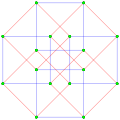

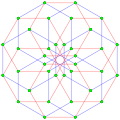


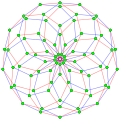



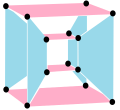

![3{6}2, or , with 24 vertices in black, and 16 3-edges colored in 2 sets of 3-edges in red and blue[14]](http://upload.wikimedia.org/wikipedia/commons/thumb/3/36/Complex_polygon_3-6-2.png/120px-Complex_polygon_3-6-2.png)
![3{8}2, or , with 72 vertices in black, and 48 3-edges colored in 2 sets of 3-edges in red and blue[15]](http://upload.wikimedia.org/wikipedia/commons/thumb/0/00/Complex_polygon_3-8-2.png/120px-Complex_polygon_3-8-2.png)
![3{3}3, or , with 8 vertices in black, and 8 3-edges colored in 2 sets of 3-edges in red and blue[16]](http://upload.wikimedia.org/wikipedia/commons/thumb/e/ef/Complex_polygon_3-3-3.png/120px-Complex_polygon_3-3-3.png)
![3{4}3, or , with 24 vertices and 24 3-edges shown in 3 sets of colors, one set filled[17]](http://upload.wikimedia.org/wikipedia/commons/thumb/d/de/Complex_polygon_3-4-3-fill1.png/120px-Complex_polygon_3-4-3-fill1.png)
![4{3}4, or , with 24 vertices and 24 4-edges shown in 4 sets of colors[17]](http://upload.wikimedia.org/wikipedia/commons/thumb/4/46/Complex_polygon_4-3-4.png/119px-Complex_polygon_4-3-4.png)
![3{5}3, or , with 120 vertices and 120 3-edges[18]](http://upload.wikimedia.org/wikipedia/commons/thumb/2/20/Complex_polygon_3-5-3.png/120px-Complex_polygon_3-5-3.png)
![5{3}5, or , with 120 vertices and 120 5-edges[19]](http://upload.wikimedia.org/wikipedia/commons/thumb/b/b9/Complex_polygon_5-3-5.png/119px-Complex_polygon_5-3-5.png)



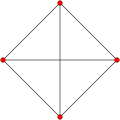
![3{3}3{3}3, or , has 27 vertices, 72 3-edges, and 27 faces, with one face highlighted blue.[25]](http://upload.wikimedia.org/wikipedia/commons/thumb/d/df/Complex_polyhedron_3-3-3-3-3-one-blue-face.png/120px-Complex_polyhedron_3-3-3-3-3-one-blue-face.png)
![2{4}3{3}3, has 54 vertices, 216 simple edges, and 72 faces, with one face highlighted blue.[26]](http://upload.wikimedia.org/wikipedia/commons/thumb/1/1d/Complex_polyhedron_2-4-3-3-3_blue-edge.png/120px-Complex_polyhedron_2-4-3-3-3_blue-edge.png)
![3{3}3{4}2, or , has 72 vertices, 216 3-edges, and 54 vertices, with one face highlighted blue.[27]](http://upload.wikimedia.org/wikipedia/commons/thumb/8/86/Complex_polyhedron_3-3-3-4-2-one-blue-face.png/118px-Complex_polyhedron_3-3-3-4-2-one-blue-face.png)




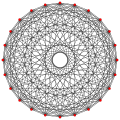


![3{4}2{3}2, or has 27 vertices, 27 3-edges, and 9 faces[25]](http://upload.wikimedia.org/wikipedia/commons/thumb/8/8d/3-generalized-3-cube.svg/118px-3-generalized-3-cube.svg.png)







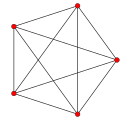
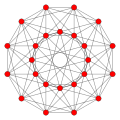


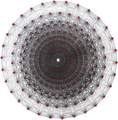


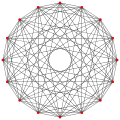
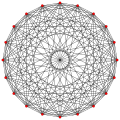


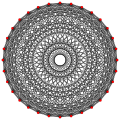
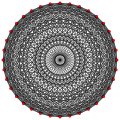



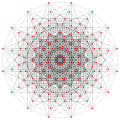
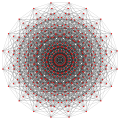













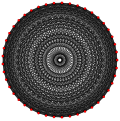
















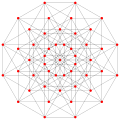
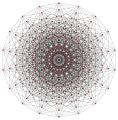

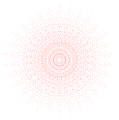
































![(1 1 22)4, has 80 vertices, 640 edges, 1280 triangular faces and 640 tetrahedral cells, seen in this 20-gonal projection.[43]](http://upload.wikimedia.org/wikipedia/commons/thumb/e/ec/Complex_4-polytope_almost_regular_80_vertices.png/120px-Complex_4-polytope_almost_regular_80_vertices.png)